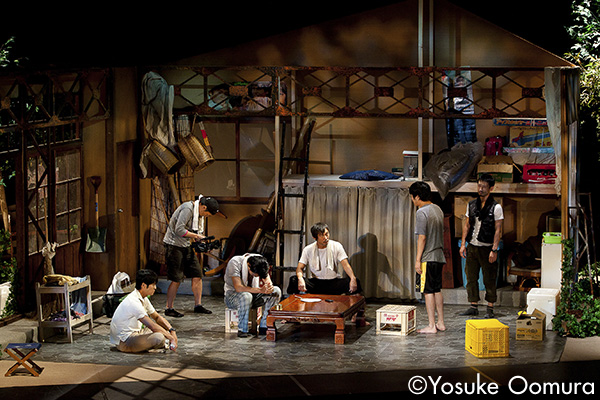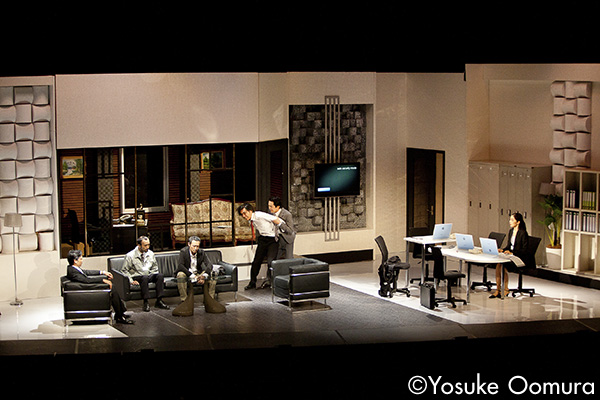The play begins in a room in the Press Club in Tokyo’s Nagatacho district just after the earthquake and tsunami. A broadcasting company employee named Shunsuke Komoto, a national Diet member named Odagiri with whom Komoto has a close working relationship and some foreign press correspondents are discussing the unfolding events. They talk about the government’s desire to protect the Tokyo Electric Power Company in the face of the nuclear power plant accident and how that is making it difficult for the media and press to run broadcasts and articles critical of the situation.
Act two moves the setting ahead to that summer. Komoto has led a TV crew to the city of Ishinomaki in the disaster area to visit a fishing family named the Kataoka who lost their home in the tsunami and are now living temporarily at a farmer’s house. They film the family and the volunteers who have come to help them and scenes of the family’s interaction with the neighbors to make a documentary program. The disaster had made Komoto painfully aware of the limitations of TV news broadcasting and he asked to be shifted to the documentary program production department.
The Kataoka family now consists of the father, daughter and son. The children’s mother died in the tsunami. The father, who was a fisherman before the tsunami, doesn’t know when he will be able to get a boat operable and return to work. The daughter Yu is in the medical school of Tohoku University and studying to become a doctor. The son Taiyo is a high school who will soon be taking his university entrance exams.
Taiyo had been stealing goods from a canning factory and selling them. The owner of the factory has come to ask Taiyo to return some if not all of the profits he had made. Since the tsunami the canning factory has been unable to restart production and the owner now has a mountain of debt. But, all Taiyo is able to produce is a few thousand yen to give the owner. Having hoped for more, the disheartened owner leaves to start home. But, just as he reaches the street he is hit by a National Defense Forces truck and killed. It doesn’t become clear in the course of the play whether it was an accident or a suicide.
Seeing the body of the heroic factory owner at the funeral, Komoto is at a complete loss for words. But, when Taiyo and Yu see it, their honest response is, “How beautiful he looks.” It must be in comparison to the corpses they saw after the tsunami, but hearing their words shocks Komoto. He realizes what a profound difference there is in the perspective on life and death that now exists between his own and that of these young people who experienced the tsunami.
Sensing the overwhelming strength of life force in this sister and brother that people who didn’t experience the tsunami could never gain in a lifetime, Komoto confesses to himself: “They have no hopes, but their lives go on. As for me, I simply remain alone, stranded on this remote backwater island.”
On the screen we see images of the areas stricken by the tsunami and the destroyed nuclear power plant. The falling rain has turned into money and the main title is shown.
Act three moves us ten years into the future.
The flight of Japanese corporations and their manufacturing to overseas bases that had begun before the Great East Japan Earthquake and Tsunami has accelerated due to lack of electrical power and the increase in corporate taxes to fund the recovery projects in the stricken areas. Solar energy has not been able to produce enough electricity to remedy the shortages caused by the lost nuclear power plants. The government has changed direction with its energy policy to resume support for nuclear power plants. There have been incidents such as politicians supporting nuclear energy being assassinated by anti-nuke radicals, and tension has grown nationwide as a result.
Komoto has quit his job at the television station and found a new job with a security company that protects prominent figures in the business and political worlds. The politician Odagiri from act one has now become a government minister and he has come with his secretary to visit Komoto’s security company office. That secretary is the Ishinomaki high school student at the time of the tsunami, Taiyo. The year after the tsunami, Taiyo succeeded in passing the difficult entrance exam to enter the elite Tokyo University. After graduation he entered the Ministry of Finance and now works as Odagiri’s secretary.
Taiyo’s sister Yu comes in, hoping to use her brother’s connection to Odagiri to ask for the Minister’s help. She is now a doctor studying the effects of small amounts of radiation exposure on human cells and wants to get official government recognition for the results of her research. But, Odagiri brusquely rejects her proposal, saying that the government can’t be paying compensation to people for just small levels of radiation exposure.
Meanwhile, employees of Komoto’s security company have caught word of a rumor that a truck with a high radiation count has entered Tokyo. Odagiri prepares to go inspect the site, but he finds the room’s door is locked and he is unable to leave. Odagiri is being held prisoner. Then, Taiyo pulls a detonating device out of his bag.
Taiyo threatens Odagiri with the detonator, telling him to call the Prime Minister immediately. He wants the government to officially recognize his sister’s research results, and to put a stop to the planned release of new government bonds to finance the construction of new nuclear power plants. Instead, he wants the bond issue to finance the construction of tree-shaped solar generation structures to replace trees lining the city boulevards.
Odagiri accepts the conditions, but it turns out the bomb was a fake. Taiyo says he will now be arrested for causing the disturbance, but he asks Odagiri to accept his proposed plans. Of course, Odagiri’s answer is No.
As Taiyo is taken away the incident appears to be resolved, but Komoto has decided to help Taiyo escape before he reaches the police station.




